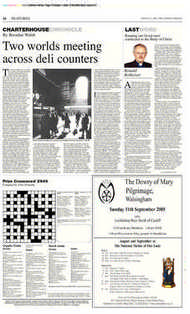Page 13, 12th August 2005
Page 13

Report an error
Noticed an error on this page?If you've noticed an error in this article please click here to report it.
Tags
Share
Related articles
Recalling The Milestones In The Life Of The Mother Of God
Our Personal Incarnations
Why Wallace Has Gone To China
'how Far Can You Go?'
China And Japan
John Paul Ii: The Feminist
The uselessness of Chinese au pairs
From China with Love: A Long Road to Motherhood by Emily Buchanan, Wiley £14.99 ‘The whole business of having our own biological child was becoming an emotional roller coaster and I wanted to get off now. No more of these false hopes, these hints of life that shone briefly and then were snuffed out at the first whiff of an ultrasound machine.” Before starting a family Emily Buchanan, a successful and respected BBC producer and foreign correspondent, had produced fascinating news copy on the consequences, good and bad, of international adoption. She was highly aware of how China’s “one child” policy had caused the abortion, murder and rejection of millions of baby girls, and she had learned a great deal about female infanticide in China and India, and illegal baby-selling in South America.
So when, after her third miscarriage, she tentatively asked her husband, Gerald Slocock, “Shall we adopt?” it is hardly surprising that his reply was an instantaneous “Of course.” She was, after all, something of an expert already; she was to become even more of one.
Emily Buchanan’s thoughtful and wellresearched account of adopting two baby girls from China makes a convincing case for adoption without shirking its grimmer aspects. She also exposes the paucity of support for parents trying to adopt.
Childless couples who want fertility treatment have the might of the NHS on their side and the sympathy and emotional support of society as a whole. Prospective adoptive parents, however, are more or less told: you’re on your own. To adopt from China, for example, parents must pay a £1,700 fee, and it is not at all certain where this money goes, though Buchanan’s research suggested most of it probably ends up with the orphanage from which the child came.
Adoption, it can be argued, is the most humane, the most morally effective way of responding to the growing crisis of childlessness. Here are parents who want a child; here is a child who urgently needs parents. Let’s bring them together.
But it is the very simplicity of the equation that makes people distrust it. Life, they feel, should not be that straightforward, so we must darned well make sure it is not easy.
Consequently, Jade and Rose, the two enchanting little girls who eventually came into Emily Buchanan’s life, could not even be contemplated until Emily and Gerald had submitted to a Home Study, the notorious assessment by local social services officials of potential adoptive parents.
Emily sees the point of the Home Study but she is quietly critical of the system, which demands sometimes mysterious and arbitrary standards of adoptive parents, standards few natural parents could hope to attain. A bad Home Study can and does dash many a couple’s hopes of parenthood for ever – and for apparently subjective, judgmental reasons. Emily had heard of couples denied the right to adopt because they had too many books, or because one of them was a solicitor and the other a teacher, and this meant, in the eyes of the social worker, that they would be too “controlling”.
Potential adopters, she knew, had been turned down for planning to return to work, for being a bit depressed (as if a couple desperate for children were supposed to be Mr and Mrs Happy-Go-Lucky all the time), for suffering from a chronic illness or for having “unresolved issues about religion”; “for being too fat, too busy, too bright, too wellread or even for having children already who were ‘too well adjusted’.” Emily interviewed parents and even an anonymous social worker, concluding that the latter rarely have any contact with middle-class families except through the inquisitorial Home Study. This is, she feels, at the bottom of the huge antipathy towards middle-class couples seeking to adopt: a case of unfamiliarity breeding contempt.
The process begins with a huge self-description known as Form F. “We had to write descriptions of our family, our accommodation, neighbourhood, access to local amenities... And then there was the obscure Ecomap. This wasn’t anything to do with eco-tourism, but a series of circles, like planets in orbit, swirling around a larger circle representing myself and Gerald. Inside this strange universe we had to write down our support networks: neighbours, close family, extended family, church groups, doctors, clubs and friends.” The “clubs” section caused the social worker to bridle, for Emily and Gerald had written down the names of two cricket clubs and the London Irish rugby club; “Isn’t there rather a gender bias here?” they were asked. “I feared a black mark against us,” Emily writes.
In addition, the couple are asked searching questions about their own relationship, their previous relationships and the inevitable “Have you grieved your infertility?” Gerald scored points for his mother’s record of fostering stray children in Yorkshire, and – encouragingly – for having taken handicapped youngsters to Lourdes; this Catholic custom seemed to counterbalance Emily’s own rocky childhood. That her mother was a manic depressive who committed suicide when Emily was nine was hardly something Emily could change, yet she was deeply aware that once the social worker learned about this tragedy, their future as parents would be on a knifeedge.
It is heartening for the rest of us, having been persuaded by the media that all social workers are Stalinists or incompetents or both, that Emily and Gerald – a posh, half-Catholic couple with a manic depressive suicide in the background – were passed as suitable adopters. I suspect that what swung it for them was their willingness to embrace their children’s Chinese heritage, for anyone planning to adopt must take on board the need for children to have a strong identity of their own.
Thus, much of Emily’s story is a China travelogue. Before, during and after the adoption process the couple toured the districts in which they knew their daughters were born, absorbing the sights, sounds and history of the local landscape.
They learned Mandarin, engaged a Chinese language teacher for Saturday breakfast lessons. They tracked down orphanage directors and did everything short of discovering Jade’s and Rose’s actual birth mothers.
They even tried to hire Chinese au pairs but, writes Emily, “the Chinese students I interviewed, being ‘only’ children, had no experience of young babies. One arrived for an interview wearing stiletto patent leather boots and a miniskirt, and looked very perturbed at the idea of changing nappies.” The uselessness of Chinese au pairs is perhaps the least malign result of the savage “one child” policy, which must surely be one of the most disastrous – and most connived at – human rights catastrophes of our time. Millions of baby girls have been aborted, smothered, drowned and strangled. The luckier ones have ended up in grim orphanages.
Buchanan reports that these are less grim than they once were, but she also tells us that Chinese adopted children are often slow in language development and attachment – facts that tell a different story.
Dr Elizabeth Croll, of the School of Oriental and African Studies in London, tells Emily that even if the “one child” policy were dropped, girls would still be discriminated against because “one of the main reasons parents prefer to have a son is that there is little or no social security or pension provision, especially in the countryside”. People believe that if you raise a daughter you provide future security for someone else; raise a son and you provide for yourself. There are attempts by Unicef and the Chinese government to persuade country folk that girls are good too, but unless social security provision improves, the basic economic facts that underpin prejudice against girls will remain.
Emily Buchanan has provided not only a readable account of adoption and the hugely important issue of the world’s unwanted children, but also a life-affirming, immensely brave response to the inability to conceive naturally. She shows that adoption can be, in its way, just as glorious and exciting an experience as giving birth. “I have almost forgotten that I’d once wanted to give birth,” she says at the end of her story. “Now Jade and Rose are simply my children.”
Sarah Johnson
blog comments powered by Disqus

















